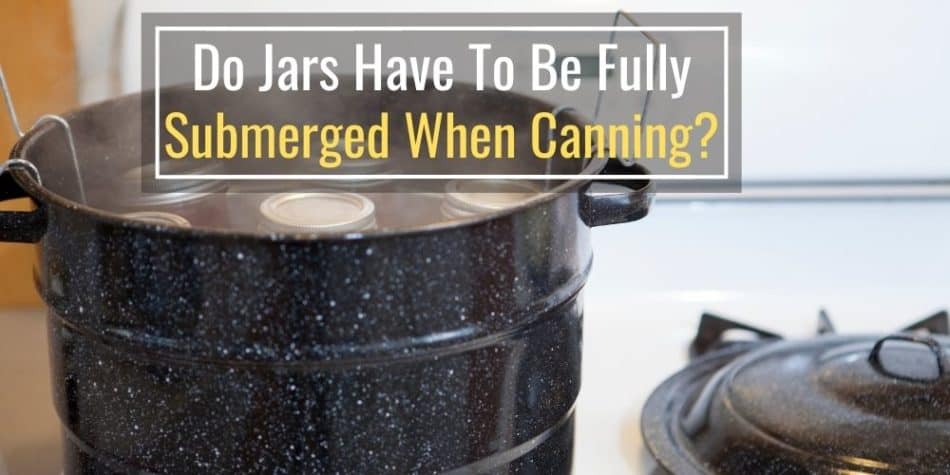Canning is an excellent method to preserve food for long term storage.
Canning works by heating a container to a level that will kill off the bad-microorganisms that can cause food spoilage or poisoning. As the container heats the air is driven out of it, and a vacuum seal forms as it cools back down.
This seal ensures that no contaminated air can enter back in.
There are two main methods of canning, which we will discuss in further detail in just a moment. These two methods are water bath canning and pressure canning, and mason jars can be used in either method.
Now to the original question, do jars have to be fully submerged when canning?
Jars need to be fully submerged while water bath canning. However, jars do not need to be fully submerged while pressure canning.
Now lets cover the different canning methods in greater detail so you know why a jar needs to be submerged while canning.
A Brief History of Canning
During the Napoleonic war, the French government offered a large award to anyone who could come up with a quick and affordable method to preserve food.
The prize went to Nicolas Appert who found food cooked in sealed jars wouldn’t spoil.
Using Appert’s methods other inventors gradually evolved the process, also coming up with the idea to use tin cans.
What Can Be Canned?
Canning can help preserve a variety of foods, including fruits, vegetables, meat, and seafood.
You will also see jams and jellies canned, as well as soups, sauces, and legumes.
Some unique ideas for canning include pie filling, whole lemons for tea, caramelized onions, and even minced garlic!
Water Bath Canning
The most important thing to know about water bath canning is that it is only intended for acidic foods. The food you wish to preserve must have a pH below 4.6 meaning it is fine for pickling and for some acidic fruits.
You may also add an acid such as lemon or citric acid if you wish to can tomatoes, as long as you take care to follow the correct procedures.
No matter how long you boil a jar in water, it will never reach a temperature higher than 100°C/212°F, which is water’s boiling point.
The main aim of canning is to destroy any microbes that may contaminate food. Certain spores and bacteria need a higher temperature to kill off, which means water bathing is not enough.
Make sure you are following the proper canning process for the food you wish to preserve.
Another thing to take into account when canning is your altitude. The University of Nebraska Institute of National Food and Resources states that varying altitudes can change the temperature water boils at. Higher altitudes mean you may need to add processing time to your recipe.
As we stated above, jars have to be fully submerged when canning using the water bath method.
If your processing time will be over 20 minutes you should submerge your cans under two inches of water. If your processing time is less, make sure you submerge under at least one inch.
This is to ensure that if the water boils down your jars won’t peak out the top. It is a great idea to keep a boiling kettle nearby just in case, so you can add boiling water if necessary.
Another important note is that while you may use smaller jars than your recipe requires you to, you should never use larger ones. Always keep jars upright and never place them on their sides while heating as this may cause leakage.
A helpful hint for water bath canning is to add a little bit of vinegar to the water. This will help prevent the outside of your jars from becoming cloudy.
Pressure Canning
The first thing to know when looking at pressure canning is that a pressure canner is NOT the same thing as a pressure cooker.
Pressure canning uses steam to help raise temperatures above the levels of 240°F, which water bath canning cannot do. Using incorrect methods of canning can lead to botulism poisoning, which can be fatal.
As with water bathing, it is also important to take altitude into consideration. Higher altitudes may require a higher pressure level.
Your pressure canner will come with instructions on how much water to use, and there is usually a marker showing you how far to fill.
Though pressure canners can look very complicated, they allow you the versatility to can many different products including stocks and sauces.
Choosing A Jar
Now that you’ve chosen which method of canning is right for your needs, it’s time to choose a jar!
Canning—or Mason—jars can be split into two main categories.
- Wide mouth jars have a 3” diameter and are best for whole foods.
- Regular mouth jars are slightly smaller and are best for pourable foods.
Then there are the other differences….some cans have shoulders, which make them better for cupboard storage. Others are slim and tapered which makes them better for the fridge or freezer.
There are also multiple different sizes to choose from, depending on what you wish to can!
Final Thoughts
Canning at home can be a great way to preserve food, especially home grown food. It also gives you the benefit of knowing your food is free of excess salt and preservatives.
It is important to ensure you are using the correct method of canning, as this will prevent any spoilage or contamination.
Just remember, when using the water bath canning method jars have to be fully submerged, and when pressure canning they do not!

